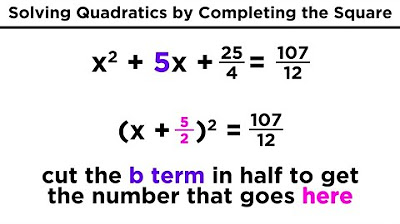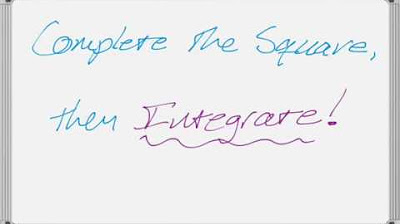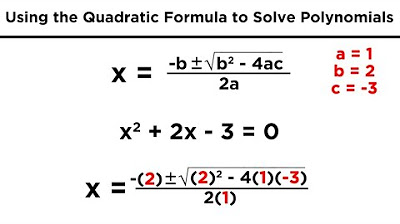Completing the Square Made Easy (Precalculus - College Algebra 19)
TLDRIn this educational video, the presenter delves into the concept of completing the square, a method for solving quadratic equations. The video aims to demystify the process by not only guiding viewers through the steps but also by explaining the underlying principles. The host emphasizes the importance of understanding why completing the square works, rather than just memorizing the procedure. This knowledge is highlighted as essential for more advanced mathematics courses, such as calculus, where the method is occasionally required. The video provides step-by-step examples, starting with simpler quadratics and progressing to more complex ones involving fractions. It also touches on the use of the quadratic formula as an alternative solution method when completing the square is not feasible. The presenter's approach focuses on engaging the audience with a clear, logical explanation, making the concept of completing the square more accessible and less intimidating.
Takeaways
- 📚 Completing the square is a mathematical technique used to solve quadratic equations by transforming them into a perfect square trinomial, which can then be solved using the square root method.
- 🔍 The process involves understanding why completing the square works and how it can be a powerful tool in advanced math subjects like calculus.
- 🧩 The key to completing the square is to take a quadratic equation and force it to factor into a perfect square, which allows for the use of the square root method to find solutions.
- ⚖️ When modifying one side of the equation by adding or subtracting, it's crucial to balance the equation by performing the inverse operation on the other side to maintain equality.
- 🔑 Finding the correct numbers to add to the quadratic equation to form a perfect square trinomial involves identifying numbers that both add up to the coefficient of the linear term (B) and multiply to the constant term (C).
- 💡 The principle of completing the square is particularly useful in scenarios where the quadratic equation does not factor easily or where the square root method is not directly applicable.
- 📐 The technique can be applied even when the quadratic equation has fractions or complex coefficients, although it may require additional steps such as finding a common denominator or adjusting for the coefficients.
- 🚫 While completing the square is a valuable method, it is not always the most efficient for finding x-intercepts, especially when dealing with equations that have fractions or complex coefficients. In such cases, the quadratic formula may be more practical.
- 📉 Completing the square can also be used to find the vertex of a parabola, which is helpful in understanding the graph of the quadratic function and its properties.
- 📝 It is important to practice and understand the process of completing the square not just for its immediate application in solving equations but also because it builds a foundation for more advanced mathematical concepts.
- ✨ The video script emphasizes the importance of understanding the 'why' behind mathematical processes rather than just memorizing the steps, which is a valuable approach to learning mathematics.
Q & A
What is the main concept of completing the square?
-The main concept of completing the square is to transform a quadratic equation into a perfect square trinomial, which allows for the application of the square root method to solve the equation.
Why is understanding the process behind completing the square important?
-Understanding the process is important because it helps in grasping the mathematical reasoning behind the technique, which can be applied in higher-level mathematics courses like calculus.
What are the two principles involved in completing the square?
-The two principles are: (1) transforming a quadratic into a perfect square trinomial to use the square root method, and (2) maintaining the balance of the equation by adding and subtracting the same value to one side of the equation.
How does the method of completing the square relate to the quadratic formula?
-Completing the square is one way to derive the quadratic formula. It demonstrates how the formula's structure emerges from the process of creating a perfect square trinomial and solving for the variable.
What is the purpose of adding and then subtracting the same value in the process?
-The purpose is to maintain the equality of the equation. When you add a value to one part of the equation, you must subtract the same value to keep the equation balanced and unchanged, except for the manipulation needed to complete the square.
When is it appropriate to use completing the square instead of the quadratic formula?
-Completing the square is typically used when the quadratic equation is easily transformed into a perfect square trinomial, especially when the coefficient of the x² term is 1. The quadratic formula is more versatile and is generally preferred for equations that are not easily factorable or when dealing with more complex quadratics.
How does one find the numbers that need to be added and subtracted to complete the square?
-To find the numbers, you need to determine what values, when added to the middle term of the quadratic and then squared, will result in a perfect square trinomial. These numbers are typically half of the coefficient of the linear term (x term).
What is the significance of the coefficient 'a' in the context of completing the square?
-The coefficient 'a' is significant because if 'a' is 1, it simplifies the process of completing the square. When 'a' is not 1, you often need to factor it out first, which can make the process more complex.
Why might one choose to get rid of fractions when solving a quadratic equation?
-Getting rid of fractions simplifies the equation and makes it easier to apply algebraic techniques such as factoring or applying the square root method. It also avoids the complexity of dealing with fractional coefficients or terms.
How does the process of completing the square help in understanding the structure of quadratic equations?
-Completing the square helps in understanding that a quadratic equation can be rewritten in the form of a perfect square trinomial plus or minus a constant. This insight is valuable for recognizing patterns and structures in quadratic equations, which is a fundamental skill in algebra.
What is the role of the constant term in the process of completing the square?
-The constant term often needs to be 'held off' or separated from the rest of the equation during the process. This allows you to focus on creating a perfect square trinomial with the x terms, which is then combined with the constant term to maintain the equality of the equation.
Outlines
📚 Introduction to Completing the Square
The video begins with an introduction to the concept of completing the square, emphasizing that understanding the method is crucial for its application in more advanced mathematics such as calculus. The presenter aims to explain not just the process but also the reasoning behind it, highlighting the importance of this technique in solving quadratic equations and its connection to the square root method and trigonometric substitution.
🔍 Understanding the Principles of Completing the Square
The second paragraph delves into the principles behind completing the square. It discusses the idea of transforming a quadratic equation into a perfect square trinomial to apply the square root method. The presenter also covers the concept of balance in equations, explaining that any operation performed on one side of the equation must be counterbalanced to maintain equality.
🧩 Demonstrating the Process with an Example
The third paragraph presents a step-by-step example of completing the square using the equation x^2 - 6x + 9 = 0. It illustrates how to identify the coefficients that will create a perfect square trinomial and how to adjust the equation to make it factorable. The process of adding and then subtracting the same value to maintain equality in the equation is also demonstrated.
🔢 Applying the Method to Non-Factorable Quadratics
In the fourth paragraph, the presenter discusses how to apply completing the square to quadratic equations that are not factorable using the square root method. It emphasizes the need to identify the correct numbers that, when added and multiplied, will create a perfect square trinomial. The paragraph also touches on the decision-making process regarding whether to use the quadratic formula or to complete the square.
📝 Completing the Square with Fractions
The fifth paragraph addresses the challenge of completing the square when the quadratic equation involves fractions. It demonstrates how to adjust the process to find the correct numbers that will lead to a perfect square trinomial, even when dealing with fractional coefficients. The presenter also shows how to handle the distribution and combination of terms in the equation.
📐 Using the Square Root Method After Completing the Square
The sixth paragraph explains how to use the square root method after successfully completing the square. It details the steps to isolate the perfect square trinomial, take the square root of both sides, and solve for x. The presenter also discusses the implications of the solutions, such as whether they are real or complex, and how to interpret these in the context of the quadratic equation.
🎓 Conclusion and Further Applications
The final paragraph concludes the lesson on completing the square, reinforcing its utility in mathematics beyond just finding x-intercepts. It mentions that while the quadratic formula is often more efficient for practical problems, understanding and being able to complete the square is valuable for more advanced mathematical concepts that the viewer will encounter in the future.
Mindmap
Keywords
💡Completing the Square
💡Quadratic Equation
💡Square Root Method
💡Factoring
💡Perfect Square Trinomial
💡Quadratic Formula
💡Precalculus
💡Trigonometric Substitution
💡Distributive Property
💡X-intercepts
💡Parabolas
Highlights
The video explains the concept of completing the square, a method for solving quadratic equations.
Completing the square is not always easy, but understanding the process makes it simpler.
The video emphasizes the importance of understanding the math behind completing the square rather than just memorizing the steps.
Completing the square can be a powerful tool in higher-level math courses, such as calculus and trigonometry.
The process involves turning a quadratic equation into a perfect square trinomial to use the square root method.
The video introduces two key principles for completing the square: understanding the process of creating a perfect square and balancing the equation.
The first principle is to transform the quadratic into a factored perfect square trinomial to apply the square root method.
The second principle is about equation balance: if you add to one side of the equation, you must subtract the same amount on the other side.
The video provides a detailed example of completing the square with the equation x^2 - 6x + 9 = 0.
The process involves identifying the missing number that would make the quadratic factorable.
The video explains how to find the missing number by setting up and solving two equations based on the coefficients of the quadratic.
The video demonstrates that completing the square can be used to solve quadratics that are not easily factorable.
The process of completing the square is shown with the equation x^2 + 4x - 3 = 0, which is not easily factorable.
The video shows how to find the number to add to the quadratic to make it a perfect square trinomial, using the equation x^2 - 3x + 1.
Completing the square can lead to real solutions, complex solutions, or no real solutions, depending on the quadratic equation.
The video concludes by emphasizing the value of understanding the 'why' behind completing the square for future mathematical studies.
Transcripts
Browse More Related Video

Proving the Quadratic Formula - Twice (Precalculus - College Algebra 20)

Solving Quadratics by Completing the Square

Calculus Complete the Square and Integrate

Solving Quadratics by Using the Quadratic Formula

How to Solve By Completing the Square (NancyPi)

How to Solve Quadratic Equations using Three Methods - When Leading Coefficient is Not One
5.0 / 5 (0 votes)
Thanks for rating: